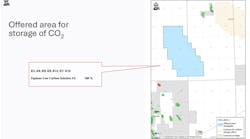Further incentives on horizon
William Furlow
Editor-in-Chief
Recognizing the opportunities, as well as high upfront costs, of deep shelf gas exploration, the US Minerals Management Service has extended deep shelf royalty relief to existing leases, and included a credit for wells drilled, even if they do not produce.
The first MMS deep gas royalty relief was initiated three years ago in an effort to stimulate more exploration activity on newly leased blocks in the Gulf of Mexico shelf. This royalty relief was specifically designed to encourage operators on the shelf to access deep pockets of natural gas. These are a mostly untapped resource that could represent 5-10 tcf of reserves. The relief was applied to wells completed at least 15,000 ft true vertical depth (TVD) below the mudline in water depths no greater than 200 m.
null
The response to this measure has gained momentum, leading to the drilling of more deep wells on the shelf. As far as it goes, this relief achieved its goal, but it ignores a major component of shelf development. After decades of production, the majority of promising on-shelf properties are already under lease. It is a challenge to drill a successful deep shelf well in general, but to make a discovery among the available leases is even more difficult.
Broader incentive
These wells are complex to drill, and the cost of a dry hole is substantial. Most of the operators on the shelf are smaller independent companies that cannot afford the high risk of such a drilling program. To address this issue, the MMS has proposed a new rule that would extend the scope of the original royalty relief. The new rule offers royalty relief on deep shelf wells drilled on existing leases. If finalized, the rule will grant relief to wells drilled after the issuance of the proposed rule, March 26, 2003. There are two basic levels to this relief. The first tier covers wells drilled at least 15,000 TVD from mudline to completion. These wells will receive relief on a minimum of 15 bcf of gas. In addition, wells drilled beyond 18,000 ft TVD will receive royalty relief on a minimum of 25 bcf.
Relief credit
One of the shortcomings of royalty relief, from the point of view of the operator, is that to receive it the operator has to make a discovery. After all, if there is no production, there is no gas on which to receive royalty relief. Recognizing the high cost of drilling these wells, the MMS has added an attractive incentive to this new rule. Wells that meet the first tier requirements of this rule will receive 5 bcf of royalty relief credit, even if they are not successful. This credit can be received on up to two wells. If two dry holes are drilled, the operator would accrue a 10-bcf credit that could be added to the 15 bcf to be received on a future, successful well drilled on the same lease.
Drivers
The key drivers for this relief are two fold. Operators have drilled out most of the conventional leases on the shelf. Any new, large finds will have to come from these deeper horizons. With declining gas reserves, the government is keenly interested in stimulating production. The problem is, the industry has very little history drilling at these depths. Such wells have various technical challenges and require additional rig capabilities that make them expensive to drill. Royalty relief is designed to offset this cost and motivate more operators to try their hand at deep-shelf prospects.
While the MMS will not receive royalties on this early production, the logic is that once these wells come online they will produce large amounts of gas. Such activity also provides valuable offset data that can be applied to the drilling of future wells at the same level.
From an operator perspective, there is a steep learning curve associated with drilling deep shelf wells. As royalty relief removes some of the financial obstacles, the hope is that the experience gained by increased activity will produce efficiencies. The more deep shelf wells drilled, the more efficient the drilling companies will become. Some companies are reporting faster penetration rates, reduced costs, and fewer rig days for such wells. Much of this savings is credited to lessons learned.
The next step
The proposed rule should move forward to be approved by early summer. But industry advocates, such as the National Ocean Industries Association, are already looking toward an even more attractive package that would offer a third tier of relief. Tom Michels, director of public affairs for NOIA, said natural gas production could be further stimulated if a third tier of relief is implemented that would encourage development below the 20,000-ft mark. Michels argues that the significant differences in exploration challenges and pressure regimes at depths of 20,000 ft and greater merit a higher level of royalty relief.
Obviously the deeper the well, the greater the temperatures and pressures and the more expensive it becomes. There is thought to be great potential for on shelf wells at this depth, but to stimulate more activity, it would be necessary to offer an added incentive. The cost to the MMS of the further incentive would be more than offset by the benefits of the new production is would create.
"You're stimulating production that otherwise would not be there," said Michels. The third tier would offer 35 bcf of relief for wells completed at 20,000 ft TVD or greater. Language authorizing this third tier of relief has been included in both the US House of Representatives and US Senate versions of the comprehensive energy bill.
"The language differs slightly between the two versions, but the upshot is the same," Michels said.
The House has passed its version of comprehensive energy legislations, but the Senate version is under ongoing debate. Assuming it passes a floor vote in the Senate, the two bills will go before a conference committee to be reconciled before being returned to both the House and Senate for a final vote. Michels said there are a number of stumbling blocks ahead, especially in the Senate, but assuming the bill passes this vote, it would go to President George Bush for his signature. While this third tier of incentive is far from a foregone conclusion, the proposed rule implementing the first two tiers of royalty relief should be finalized soon, encouraging more activity on shelf prospects in the Gulf of Mexico.





